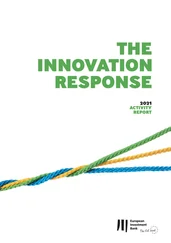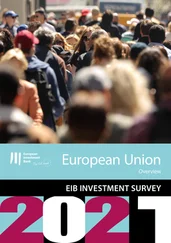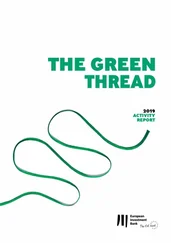Massive government support kept the increase in unemployment relatively contained at the end of the third quarter of 2020 (Figure 13).The unemployment rate rose by about 0.5 percentage points in Western and Northern Europe and Central and Eastern Europe ( Figure 13a). The increase was higher in Southern Europe (1.5 percentage points). The United States saw an increase of 4 percentage points over the same period with a peak of 10 percentage points in April. The difference between the two sides of the Atlantic can be mostly explained by significant differences in labour-market institutions and also by substantial government financing of policies to retain labour ( Box D). The effect of government measures can also be indirectly gauged by comparing the contained increase in unemployment with the steep decline in total hours worked across the European Union ( Figure 13b). This suggests that if employment was not subsidised, the increase in unemployment would have been much greater ( Box Dfor caveats).
Figure 13
Unemployment and total hours worked

Source: Eurostat and EIB staff calculations.
Increasing risks of a slow recovery and a substantial increase in government indebtedness do not bode well for the unemployment outlook in the near term.General government debt in the European Union increased by 8.5 percentage points of GDP to 88% from the first to second quarter of 2020 as the pandemic intensified. The sharp increase in debt is likely to curb governments’ ability to act as decisively should the pandemic’s second wave require further restrictions in the fourth quarter of 2020 or first quarter of 2021. With a stalled recovery and, possibly, a weaker fiscal response, unemployment is bound to increase significantly. Higher unemployment will exert additional pressure on social protection systems to extend their remit to parts of the population not covered by current programmes ( Box C).
Box C
Social protection systems and the COVID-19 shock: Adapting short- and long-term support
Social protection systems play a central role as stabilisers when economic shocks occur. Unemployment benefits are clearly countercyclical but other forms of social spending such as pensions or sickness benefits also contribute to maintaining households’ disposable income in times of economic stress. Structurally, social protection systems help to reduce the incidence and depth of poverty, improve the health of the population and facilitate access to education.
The stabilising effects of social protection systems are stronger in higher-income countries due to the size and composition of spending. EU Member States with higher incomes spend relatively more on social protection and typically place greater emphasis on sickness, family and unemployment benefits (European Commission, 2019). Following the global financial crisis, social protection expenditure increased, reflecting in particular the higher spending on unemployment benefits following the shock to the economy.
The pandemic prompted unprecedented policy action to support firms and households. The introduction and/or extension of short-time work (government programmes that subsidised the salaries of workers whose hours were temporarily reduced for economic reasons) is a distinctive feature of this crisis ( Box D) but all governments have gone further. Their action includes providing easier access to regular support instruments in the event of unemployment or sickness, a stronger emphasis on safety and health protection at workplaces, increased support for parents staying at home or additional child/family allowances. In addition, housing has emerged as a key area in limiting the negative social impact of the pandemic, with policymakers introducing measures to protect tenants and mortgage holders, such as support for payment moratoriums, suspension of evictions, or subsidies for rent and utility bills.
The pandemic highlighted some of the existing gaps in social protection systems. A lack of access can reduce their effectiveness in protecting people when they lose their jobs and income, fall sick or experience poverty. Typically, unemployment benefits and short-time work tend to be geared towards those on full-time permanent contracts. In contrast, non-standard workers, including the self-employed or those on part-time or fixed-term contracts, may lack adequate income protection and often face a higher risk of losing their jobs. Pre-crisis estimates suggest that non-standard workers are 40-50% less likely to receive income support during the periods they are out of work, and even if they do, the benefits tend to be less generous (OECD, 2019). Incentives for employers to use short-time work for non-standard staff are likely lower, particularly if firms expect some of the impact on employment to be permanent (see analysis in Chapter 2).
The prevalence of non-standard work differs across EU countries but is particularly frequent in certain sectors hit hard by the pandemic, such as hotels and restaurants or the arts and entertainment. Challenges for social policy mount in countries in which employment in these sectors is higher and non-standard employment more prevalent. Several Southern European countries appear to have a particularly high share of vulnerable workers ( Figure C.1, upper-right quadrant). By socio-demographic group, women and younger workers seem more vulnerable and have a higher probability of being non-standard workers. Moreover, informal workers are a particularly vulnerable group with few entitlements and often have limited scope for claiming benefits.
Figure C.1
Total employment and non-standard employment in activities most affected by the pandemic
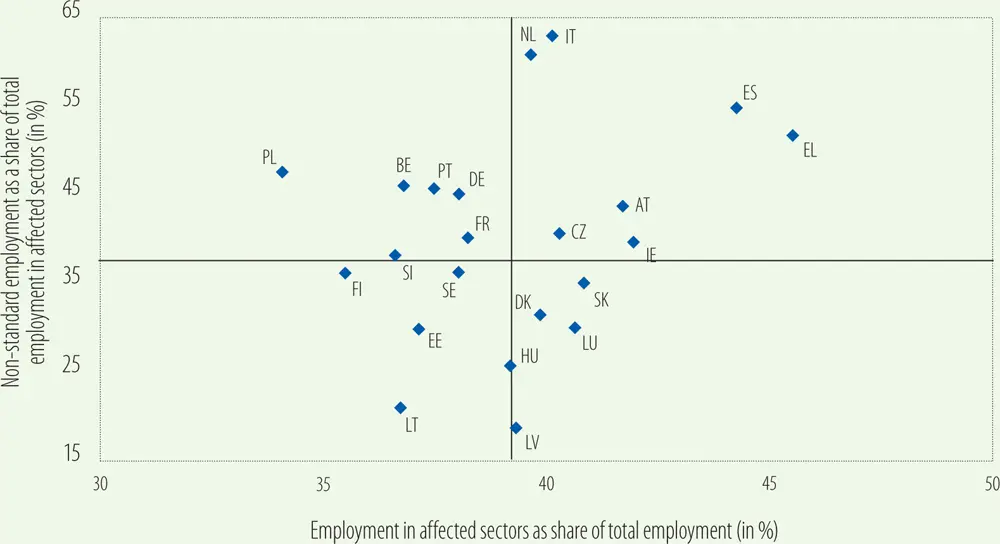
Source: OECD (2020a), OECD Annual National Accounts; EU Labour Force Survey Database; and OECD calculations, EIB Economics Department.
Note: Black lines indicate the EU average. Non-standard workers include those on temporary contracts or in part-time jobs, and the self-employed. Activities affected most by containment measures include wholesale and retail trade, accommodation and food services, real estate services and construction, professional service activities, other service activities and the arts, entertainment and recreation. See OECD (2020a) for further explanation.
Strengthening non-standard workers’ access to regular benefits and facilitating their inclusion in short-term work schemes have been a feature of COVID-19 policy responses, as a result of the spotlight cast by the pandemic on the existing gaps. Some countries have introduced special sectoral support and/or targeted measures for vulnerable groups. In Spain, for example, temporary workers whose contracts expired during lockdown before they reached the minimum contribution period for unemployment benefits received provisional allowances (ECIJA, 2020). Moreover, several countries have acted to support freelance workers and the self-employed. Relatively few actions have focused on informal workers ( Table C.1).
Table C.1
Support for non-standard and vulnerable workers in the pandemic: Income replacement and support measures in EU Member States
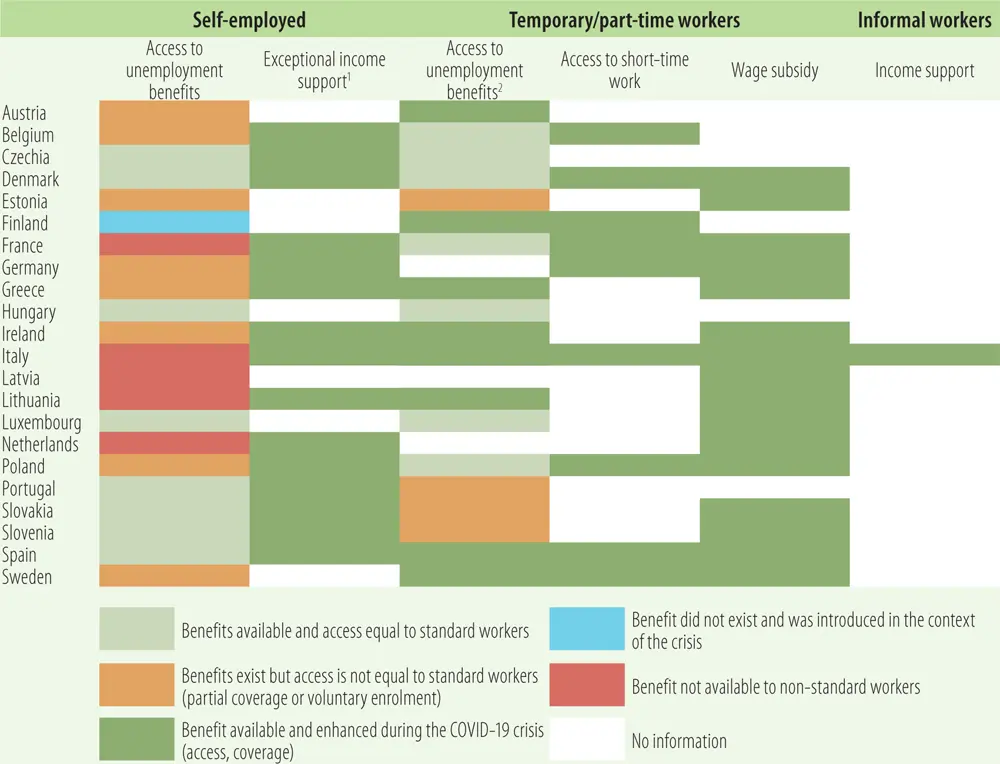
Source: OECD (2020a).
Читать дальше






